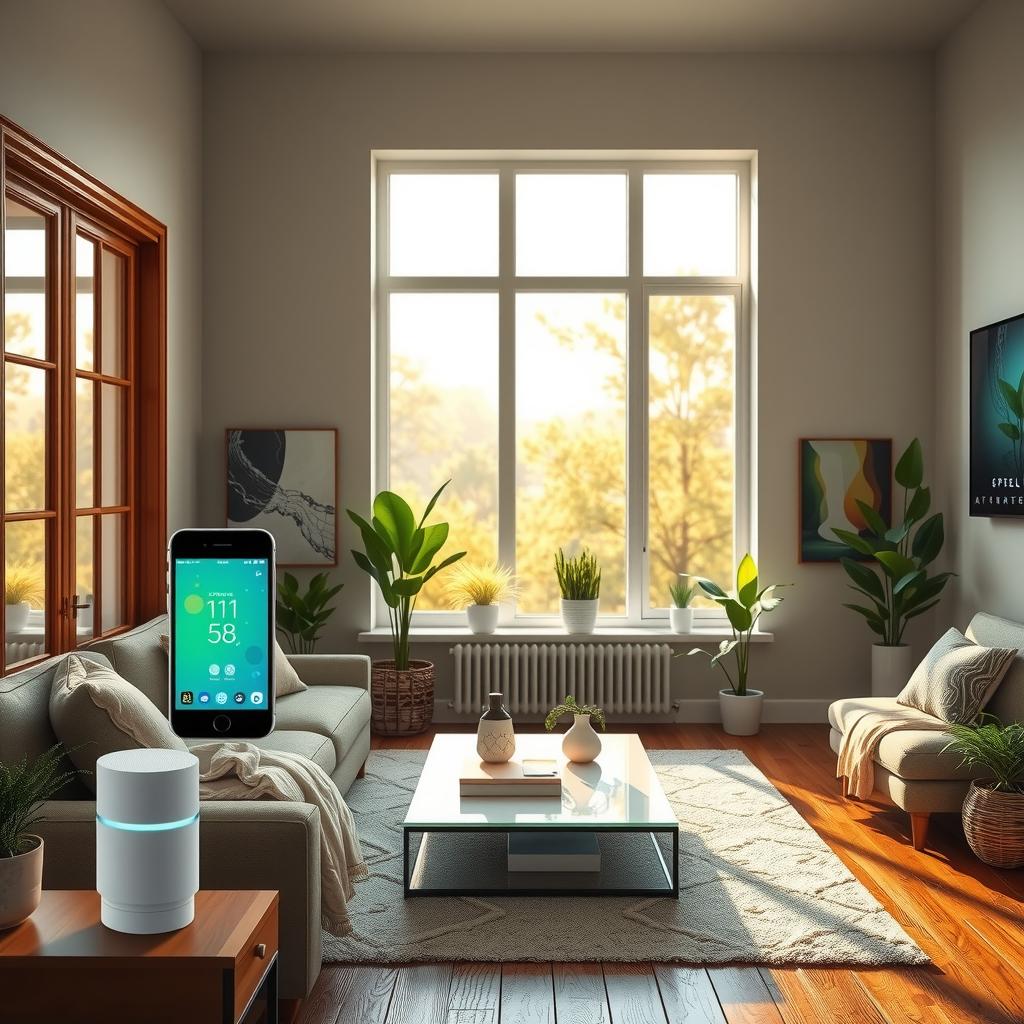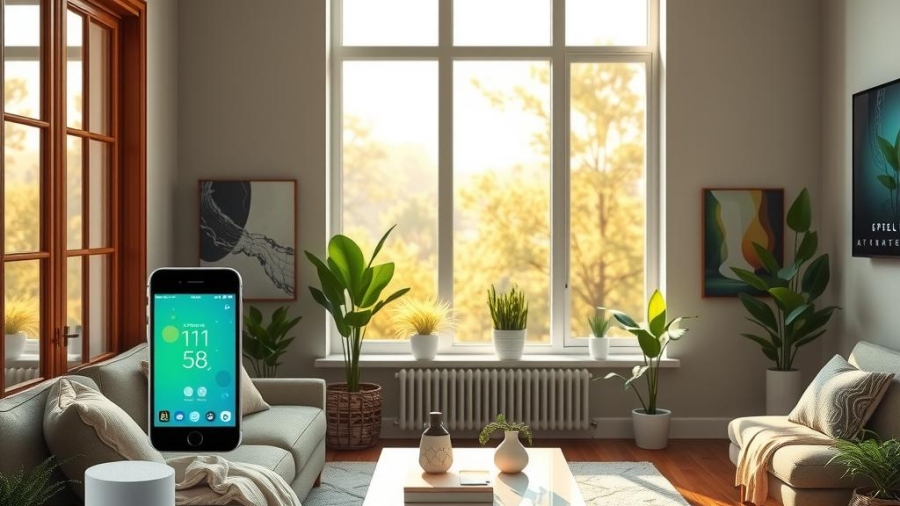In today’s world, where urban living and industrial activities contribute significantly to indoor pollution, the air quality within homes has become a pressing concern. Many people are unaware that the air they breathe indoors can be more contaminated than outdoor air, with common household products, allergens, and pollutants lurking in every corner. This alarming reality raises critical questions: How safe is the environment one creates at home? What steps can individuals take to ensure their families are breathing clean air? Addressing these concerns begins with an understanding of how a comprehensive home air quality monitoring system can serve as an effective solution.
The significance of detecting pollutants cannot be overstated; poor indoor air quality poses numerous health risks, ranging from respiratory issues to long-term chronic conditions. With various sources contributing to this problem—such as volatile organic compounds (VOCs) emitted by paints or cleaning agents—the need for robust air monitoring systems becomes evident. By implementing advanced technology designed for real-time pollutant detection, homeowners gain invaluable insights into their indoor environments. These systems not only highlight existing hazards but also provide recommendations for improving ventilation and overall safety.
Investing in a comprehensive approach allows households to tackle these challenges head-on without compromising comfort or health. As readers explore this article further, they will discover essential strategies and products that facilitate effective monitoring while promoting environmental safety. From smart sensors capable of tracking particulate matter levels to automated solutions that adjust airflow based on real-time data, there is no shortage of innovative tools available today.
This blog post aims not just to inform but also empower readers with actionable knowledge about setting up an efficient home air quality system tailored specifically for their needs. Understanding the dynamics behind maintaining optimal indoor environments will pave the way toward healthier living spaces—ensuring everyone breathes easier at home while protecting loved ones from unseen threats lurking in the atmosphere around them.

Key Points:
-
Importance of Pollutant Detection: Understanding various indoor pollutants is crucial for homeowners seeking to enhance their living conditions. By implementing an effective air monitoring system, individuals can identify harmful substances such as volatile organic compounds (VOCs) and particulate matter, thereby addressing potential health risks associated with poor air quality.
-
Strategies for Ventilation Improvement: Armed with accurate data from comprehensive monitoring, residents can make informed decisions about improving their home’s ventilation. This ensures that fresh air circulates effectively while minimizing exposure to indoor pollution, ultimately contributing to a healthier environment within the home.
-
Integration of Technology in Air Quality Solutions: The use of advanced technology plays a pivotal role in creating an effective home air quality monitoring system. Homeowners can choose devices tailored to measure specific pollutants, allowing them to foster cleaner indoor atmospheres and maintain optimal living conditions by utilizing real-time insights into their environmental safety.

Understanding Indoor Air Quality
The Silent Threat of Indoor Pollution
Indoor air quality (IAQ) is an often-overlooked aspect of environmental safety that significantly impacts health and well-being. Many individuals tend to focus on outdoor pollution while neglecting the potential dangers lurking within their own homes. Poor home air quality can arise from various sources, such as volatile organic compounds (VOCs) emitted by cleaning products, paint, or furniture; biological contaminants like mold and dust mites; and even carbon monoxide from heating systems. These pollutants can accumulate in confined spaces, leading to a range of health risks including respiratory issues, allergies, headaches, and long-term chronic conditions. It is essential for homeowners to recognize that an effective way to combat indoor pollution is through comprehensive monitoring using advanced air monitoring systems designed to detect these harmful substances accurately. By actively engaging with air quality solutions tailored for residential spaces, individuals can create a safer living environment.
The Importance of Monitoring Air Quality
Proactive Measures Against Health Risks
Monitoring indoor air quality should be regarded as a crucial component in safeguarding one’s health at home. With the advent of modern technology, innovative pollutant detection devices have become accessible for everyday use. These tools are capable of providing real-time data regarding particulate matter levels and specific gases present in the indoor environment. Regularly checking these metrics allows families to make informed decisions about ventilation improvement strategies or when it might be necessary to seek professional assistance for remediation efforts against severe contamination cases. Furthermore, awareness about common pollutants empowers residents to adopt preventive measures—like proper storage of chemicals or ensuring adequate ventilation during renovations—to minimize exposure effectively over time.
Recognizing Sources of Indoor Pollution
A Closer Look at Common Contributors
Identifying sources contributing to poor indoor air quality is vital for establishing effective control measures against pollution-related health risks. Homes today often contain numerous items emitting VOCs—from paints and varnishes used during DIY projects to household cleaners laden with harsh chemicals—which could compromise overall environmental safety if not managed appropriately. Moreover, activities like cooking produce airborne particles that contribute further toward diminishing IAQ standards if not mitigated through efficient kitchen ventilation systems or regular maintenance practices such as cleaning exhaust fans regularly. Homeowners must also consider external factors influencing internal conditions—such as nearby construction sites introducing increased dust levels into their living space—that necessitate vigilant awareness around maintaining optimal indoor environments.
Solutions for Improved Air Quality
Tailored Approaches For Every Household
Implementing targeted solutions based on individual household needs enables families to enhance their home’s overall air quality substantially while minimizing risks associated with prolonged exposure towards harmful substances found indoors. Strategies may include utilizing high-efficiency particulate air (HEPA) filters within HVAC units or standalone purifiers designed specifically for pollutant removal from circulating airflow throughout living spaces efficiently without disrupting daily routines significantly—a seamless addition promoting better respiratory function among occupants over time! Additionally, incorporating houseplants known for natural filtering properties serves both aesthetic purposes alongside improving IAQ naturally via photosynthesis-based processes which reduce harmful gases’ concentrations present indoors seamlessly integrating wellness-focused designs into residential settings effortlessly enhancing aesthetics along with functionality simultaneously!
Conclusion: Prioritizing Health Through Awareness
Empowerment Starts Within Your Home
Ultimately, understanding the intricacies surrounding indoor air quality fosters greater appreciation toward recognizing its profound influence on personal well-being—and encourages proactive engagement amongst residents striving towards healthier lifestyles! By adopting routine checks using reliable monitoring technologies combined with strategic adjustments targeting prevalent contaminants prevailing within domestic realms ensures enhanced protection shielding loved ones from unseen threats impacting daily lives adversely creating harmonious atmospheres conducive fostering vitality across generations inspiring active participation towards sustainable future endeavors collectively nurturing care beyond physical aspects transcending mere aesthetics elevating holistic approaches encompassing mind-body-spirit connections empowering communities worldwide!
Key Components of an Effective Monitoring System
Essential Tools for Ensuring Indoor Air Quality
In the pursuit of a safe and healthy living environment, understanding the key components of an effective monitoring system is crucial. The first step in addressing indoor pollution involves recognizing that various pollutants can significantly impact home air quality. Using advanced air monitoring systems, individuals can detect harmful substances such as volatile organic compounds (VOCs), carbon dioxide, particulate matter, and other hazardous materials common in residential spaces. These systems utilize a combination of sensors and smart technology to provide comprehensive data on indoor air conditions.
The effectiveness of pollutant detection hinges on employing sophisticated devices tailored for specific contaminants. For instance, some monitors are designed explicitly for detecting carbon monoxide levels, which pose severe health risks when accumulated in enclosed areas. Others focus on identifying allergens like mold spores or dust mites that may compromise respiratory health and overall well-being. By integrating these technologies into one’s environmental safety strategy, households can proactively manage potential hazards associated with poor air quality.
Moreover, many modern air quality solutions come equipped with real-time monitoring capabilities linked to mobile applications. This feature allows residents to track their home’s atmospheric conditions from anywhere while receiving alerts about unsafe levels of pollutants immediately upon detection. Such transparency empowers occupants to make informed decisions regarding ventilation improvement strategies—whether it’s opening windows during lower outdoor pollution times or using purifiers equipped with HEPA filters that effectively reduce airborne toxins.
Data collected by these comprehensive monitoring systems not only assists in immediate remediation efforts but also aids long-term planning for maintaining optimal indoor environments. Homeowners can analyze patterns over time to understand peak pollution periods or identify sources contributing to deteriorating air quality—be it new furniture releases VOCs or inadequate ventilation causing humidity issues leading to mold growth.
To enhance the functionality further, some devices integrate artificial intelligence algorithms that learn from user habits and external environmental factors affecting indoor climate stability; this results in more efficient energy consumption while ensuring cleaner air circulation throughout the living space without unnecessary costs related to over-ventilation or excessive filter replacements.
As awareness grows surrounding indoor pollution’s health risks, investing in reliable pollutant detection tools becomes increasingly essential for safeguarding family members’ well-being against unseen adversaries lurking within their homes. In summary, a robust approach toward establishing an effective monitoring system fosters enhanced knowledge about one’s environment while promoting healthier lifestyles through improved understanding and management practices concerning home air quality challenges faced today.
Enhancing Indoor Air Quality: The Importance of Ventilation
Understanding the Role of Home Ventilation in Air Quality Monitoring
Effective home ventilation plays a crucial role in maintaining indoor air quality. With increasing concerns about indoor pollution, it becomes imperative for homeowners to understand how proper ventilation can mitigate health risks associated with airborne contaminants. In homes, pollutants can accumulate from various sources such as household cleaning products, cooking fumes, and even furniture materials. Poor ventilation exacerbates these problems by trapping harmful substances indoors, leading to a range of potential health issues including respiratory complications and allergic reactions. Implementing an air monitoring system allows residents to track levels of common pollutants like volatile organic compounds (VOCs) or particulate matter (PM). By utilizing this data, individuals can make informed decisions regarding their indoor environment—such as opening windows when outdoor air quality is superior or activating exhaust fans during peak usage times. Furthermore, understanding airflow patterns within the home enables strategic placement of ventilators and filters that enhance overall efficiency in pollutant removal.
Strategies for Integrating Air Quality Solutions
Actionable Steps Toward Improved Home Ventilation
Incorporating comprehensive monitoring systems into daily life requires actionable strategies that focus on enhancing ventilation while ensuring healthy indoor conditions. First and foremost, regular maintenance checks on existing mechanical systems are essential; dirty ducts or malfunctioning fans can significantly hinder airflow effectiveness. Additionally, homeowners should consider adopting natural solutions such as cross-ventilation techniques which leverage prevailing winds to circulate fresh air without relying solely on mechanical systems. Another effective strategy involves installing high-efficiency particulate air (HEPA) filters in HVAC units—they capture allergens and other particulates effectively while promoting a cleaner indoor atmosphere conducive to wellbeing. Moreover, integrating smart technology allows users to receive real-time updates about their home’s air quality status through apps connected to sensors placed strategically throughout the space; this proactive approach empowers residents by delivering insights into possible adjustments needed for optimal comfort.
The Connection Between Environmental Safety and Health Risks
Recognizing Pollutant Detection as a Vital Component
Understanding the connection between environmental safety and human health is fundamental when addressing home air quality. Effective pollutant detection not only aids in identifying harmful particles but also helps inform necessary actions that reduce exposure risk over time—a vital component often overlooked until symptoms arise unexpectedly among occupants. When engaging with an advanced air monitoring system, families gain access to detailed reports highlighting fluctuating levels of specific irritants present indoors versus outdoors throughout different times of day or seasons; enabling them better control measures against chronic issues linked directly back towards inadequate airing practices at home—such ailments could include asthma triggers stemming from dust mites accumulating due poorly maintained spaces lacking sufficient airflow circulation capabilities altogether!
Practical Tips for Sustaining Healthy Indoor Conditions
Long-Term Maintenance Approaches for Optimal Ventilation
To ensure long-term success in sustaining healthy indoor conditions through improved ventilation methods requires commitment beyond initial setup phases alone—it demands ongoing diligence too! Regularly updating filter replacements based on manufacturer recommendations prevents clogs that ultimately diminish efficacy levels achieved previously via installation efforts made earlier down line—this simple task serves dual purpose: prolong equipment lifespan while simultaneously enhancing performance standards upheld consistently across households everywhere striving achieve maximum results concerning both cleanliness alongside general comfort experienced day-to-day basis alike! It may also be beneficial exploring additional resources available locally targeting education outreach initiatives focused around sustainable practices tailored specifically toward optimizing residential environments designed promote well-being above all else thereby creating harmonious balance between modern living conveniences coupled alongside nature’s offerings providing us respite every step way forward journey together embracing brighter futures ahead filled promise healthier lifestyles enriched enhanced experiences shared amongst loved ones gathered under one roof united purpose drive innovation progress prosperity enjoyed fully appreciated moments cherished rather than taken granted amidst busy lives lived today constantly evolving tomorrow awaits eagerly just beyond horizon beckoning welcome embrace transformation fostering growth sustainability flourishing globally recognized priorities aligned aspirations fundamentally rooted core values supporting collective endeavors pursued passionately relentlessly advancing continuously improving outcomes desired envisioned long ago still dreaming new possibilities unfolding right before eyes see clearly light illuminating paths pave way onward upward journeys never truly end only begin anew each dawn brings forth hope renewed possibilities endless opportunities await exploration discovery joy found along winding roads traveled hand-in-hand together always sharing stories laughter memories woven tapestry life intertwined forever brightening existence cherished dearly heart souls touched forevermore inspiring next generations follow footsteps laid ahead create legacies worthy remembrance celebration lasting impact world left behind those who came before shaping future yet unfold endlessly inviting all join hands forge bonds connections established bridge gaps connecting hearts minds resonating harmoniously echo loudly far wide reaching depths profound beauty resides inside every being born live thrive flourish contribute society enrich earth we call home!
Frequently Asked Questions:
Q: What are the common pollutants found in home air quality?
A: Common pollutants include volatile organic compounds (VOCs), particulate matter, carbon dioxide, and various allergens. Monitoring these substances is essential for understanding indoor pollution levels and their potential health risks.
Q: How can I improve my home’s ventilation to enhance air quality?
A: Improving ventilation can be achieved by regularly opening windows, using exhaust fans in kitchens and bathrooms, and integrating mechanical ventilation systems. These approaches help ensure fresh air circulation while reducing the concentration of harmful substances indoors.
Q: What types of devices should I use for effective air monitoring?
A: Homeowners should consider using advanced sensors capable of detecting specific pollutants such as VOCs and particulate matter. A comprehensive monitoring system may include multiple devices that work together to provide a complete picture of home air quality, allowing for informed decisions about necessary improvements.
